Mastering for Folk Music
Quick Answer
Mastering for Folk Music is the process of preparing a Folk single, EP, or album for distribution all while augmenting the sonic characteristics of the project. A good folk master should stay competitive with other albums, yet maintain the dynamics and transient detail that keep the genre sounding natural.
Mastering for Folk Music in Detail
Although Folk music can take many forms, at its root Folk is a genre that prioritizes honesty - not just in the writing, but in the production as well.

Folk music spans a lot of ground, but it does have a common foundational amongst all the subgenres.
Just like how the instrumentation and lyricism of Folk music is used to convey something genuine, a good Folk master evokes and augments this sense of authenticity.
With that in mind, certain forms of processing and amounts of that processing should be used when mastering Folk to create a great sounding master. Furthermore, certain styles of production and equipment should be considered to evoke a Folk sound , and to deliver what listeners and lovers of Folk expect.
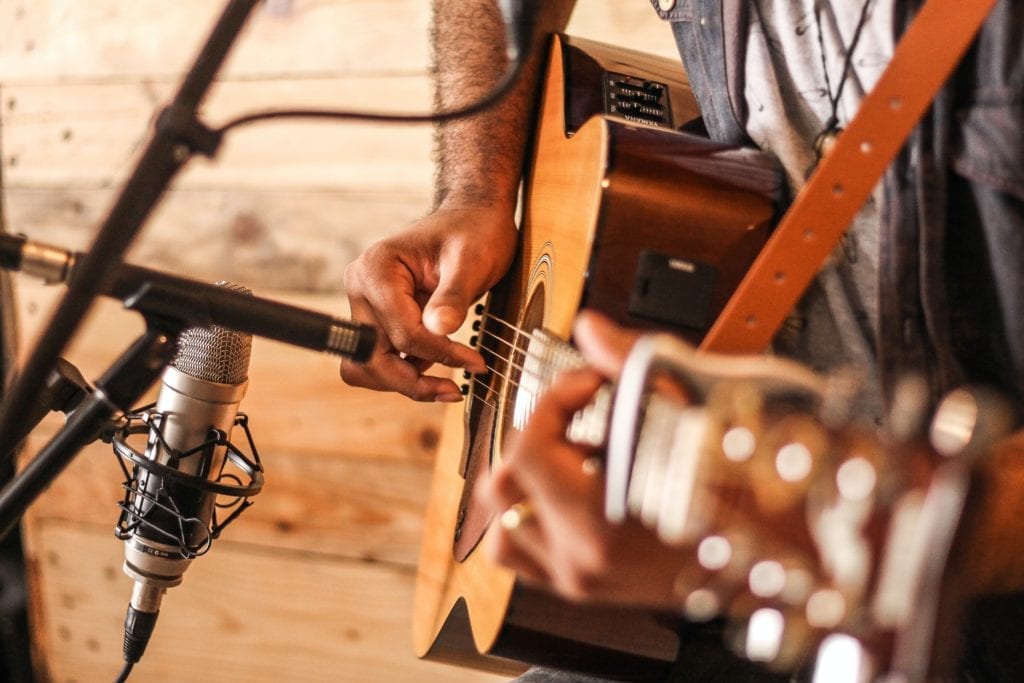
Listeners of Folk music want a natural sound.
Additionally, some metrics including overall loudness, total harmonic distortion, and the loudness range should be closely monitored and considered when mastering Folk music to ensure that a great Folk master is made.
Lastly, although certain changes can augment the sound of a Folk master, there are certain changes that should rarely if ever be made to a Folk master.
We’ll cover each one of these points as well as delve into the why this is, as we uncover what makes a Folk master sound great , and what about Folk music needs to be upheld during the mastering process.
If you have a Folk song that you need mastered, send it to us here:
We’ll master it for you and send you a free mastered sample of it for you to review.
What Makes Folk Music Unique?
Folk music has always put an emphasis on natural-sounding instrumentation that is layered and complex, yet maintains its immediacy and intelligibility. Sonically speaking, Folk music can have a full frequency spectrum with lots going on, but still maintain headroom, dynamics, and space amongst the instrumentation present.

Folk music can have a lot of layer instrumentation, yet it retains its spaciousness and dynamic range nonetheless.
In other words, Folk music, no matter how complex the composition, always sounds open and spacious, and never resorts to a highly compressed and dense sound.
Although the reason why Folk music isn’t heavily compressed or made to sound dense isn’t exactly clear, it’s most likely to maintain the natural sound of the instrumentation.
With that in mind, let’s delve into some of the production elements of mastering Folk music, that makes the process unique from mastering other genres.
How Dynamic Should a Folk Master Be?
In short, a folk master should be more dynamic than pop or hip-hop music, but not as dynamic as jazz or classical music - in other words, Folk music should be consistent dynamically, but not significantly compressed or limited. A good Folk master sounds present but not overbearing or fatiguing.
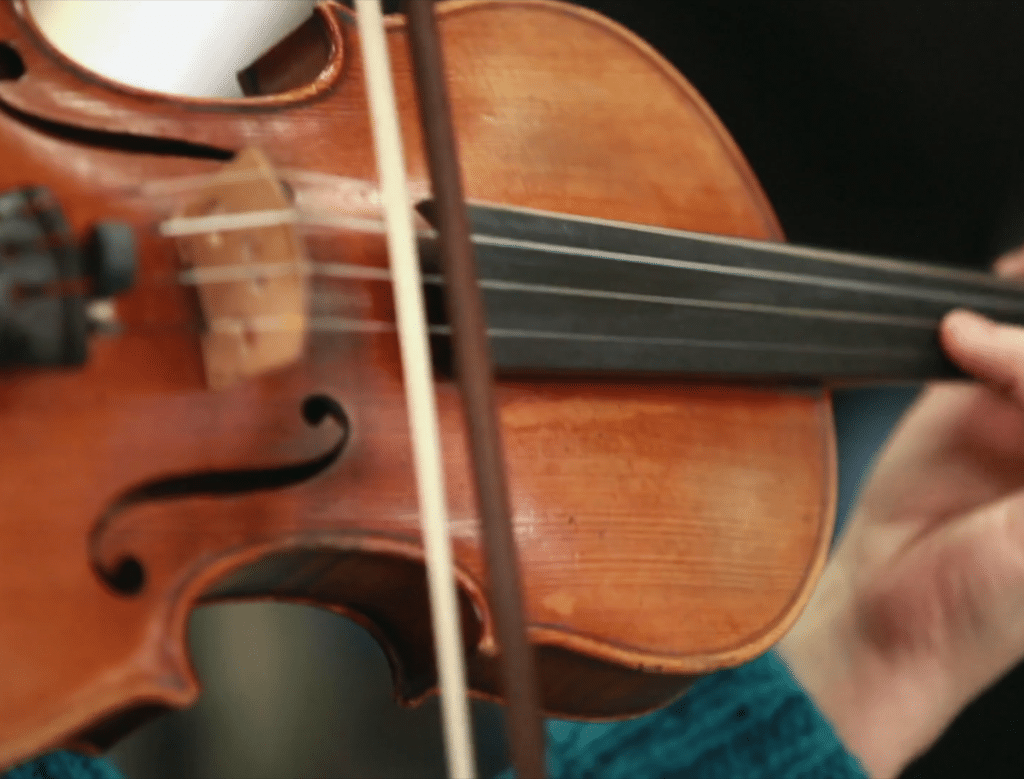
Although folk music should be dynamic, it shouldn't be as dynamic as classical music or jazz.
A Folk master needs to sound natural - for this reason, a Folk master’s dynamics should stay relatively consistent, and allow some of the quieter aspects to be perceived, even when being played on consumer-grade equipment.
So in short, mild compression and mild to moderate limiting is appropriate for a Folk master. The dynamic range in LU should be at least 6.
If your dynamic range varies greatly from this in either direction, it may mean that a more compressed or a less compressed master is needed.
How Should I Apply Compression When Mastering Folk?
When mastering folk music parallel compression should be used as a means to preserve the transients of the original signal and to avoid noticeable compression. Additionally, soft-knee compression and optical compression can be used to create a smoother sound, one that’s indicative of older records.

Parallel compression is a great way to control the dynamics of a folk master, without introducing noticeable compression.
Just like with dynamics, choosing the right compression type and compression settings for a folk master it a balancing act. On one hand, you don’t want to compress the transients that make the instruments intelligible, but on the other, you want to create a smooth and pleasant sound.
Fortunately, you can easily find a mid-ground between these two outcomes by using your compression settings mildly. It’s only when you begin to significantly compress your master that you’ll notice unpleasant consequences.
Granted, you still may want to lean toward either a transient sounding master or a smoother sounding master - so here’s how you accomplish both:
For a smooth sounding master, use optical compression with a soft-knee setting. Additionally, decrease the attack time and increase the release time.
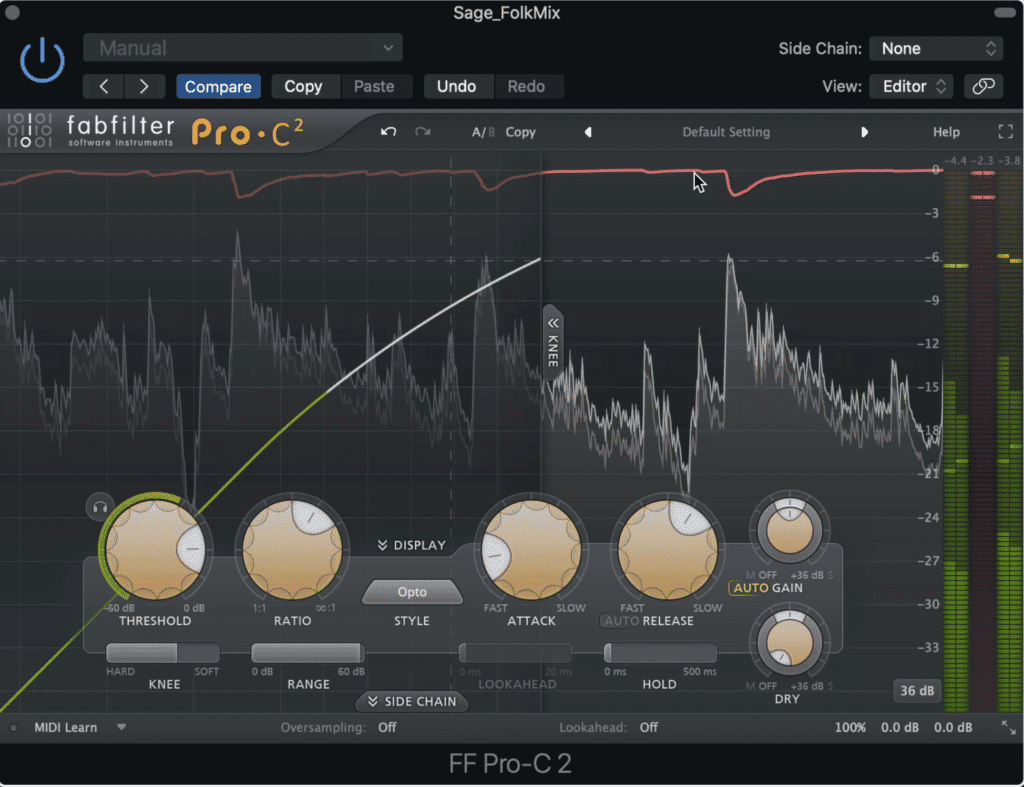
Opto settings with a quick attack and slow release will create a smooth sounding master.
These settings will capture the transient sooner and compress it for longer - in turn, making the music sound smooth and tranquil.
For a more aggressive sound - one that retains the original transients of the vocals and instrumentation, use modern compression with a hard-knee setting. Additionally, increase the attack time and decrease the release time.

A hard-knee setting with a longer attack time and shorter release will create a more modern and clean compression.
These settings will allow more transients to pass through the compressor unaffected, and only compress the signal after crossing a very defined threshold. In other words, your signal will be compressed less.
How Should I EQ my Folk Master?
When it comes to mastering Folk, the right equalization settings are just as important to creating a natural folk sound as compression and distortion. Equalization should be applied very carefully and in a more minimalistic way - too significant of a boost or cut can ruin the balance of a folk recording.
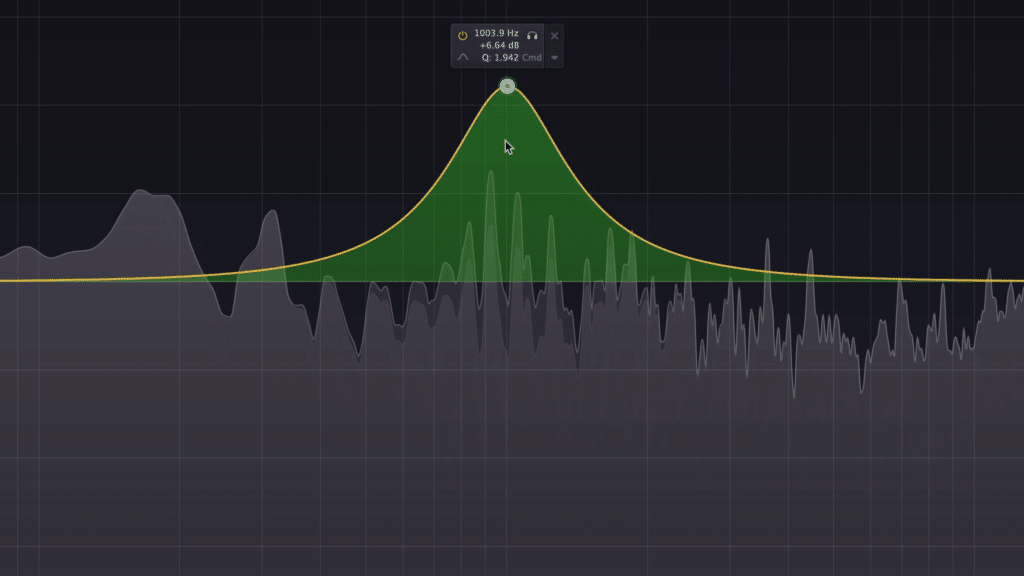
Significant cuts or boosts will make your folk master sound unbalanced.
As we’ve discussed, Folk music is predicated on a natural and balanced sound. This means that the instruments need to be accurately represented when recorded, mixed and mastered.
The mentality of capturing the instrument and vocal in the most authentic way possible carries over to Folk mixing, and it should carry over to mastering as well.
Let's consider what it means to equalize something in a natural-sounding way, and look at some settings you can use when equalizing. Also, let’s delve into what type of equalizers you should be using for folk music.
What EQ Settings Should I Use When Mastering Folk?
When mastering folk music, using larger bandwidths will result in a more realistic and musical sound - whereas small bandwidths sound unnatural and cause a more noticeable change to the mix’s timbre. Additionally, smaller changes should be made since large changes in amplitude will be noticeable.
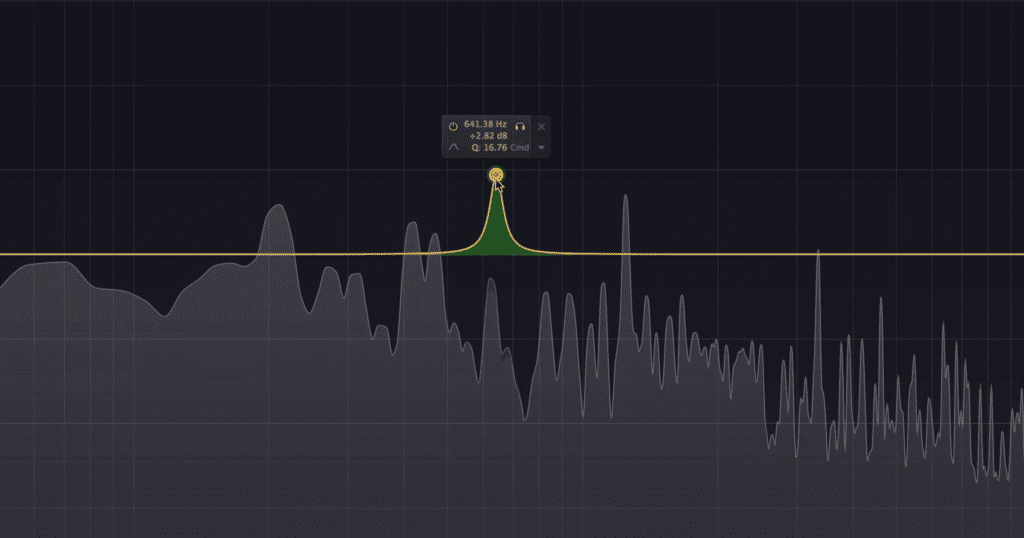
High Q, small bandwidth settings will sound unnatural and should be avoided unless truly needed for surgical EQ.
With that said, here are some Q settings you can use to create more natural-sounding equalization curves:
2 Octave Bandwidth: .667 Q
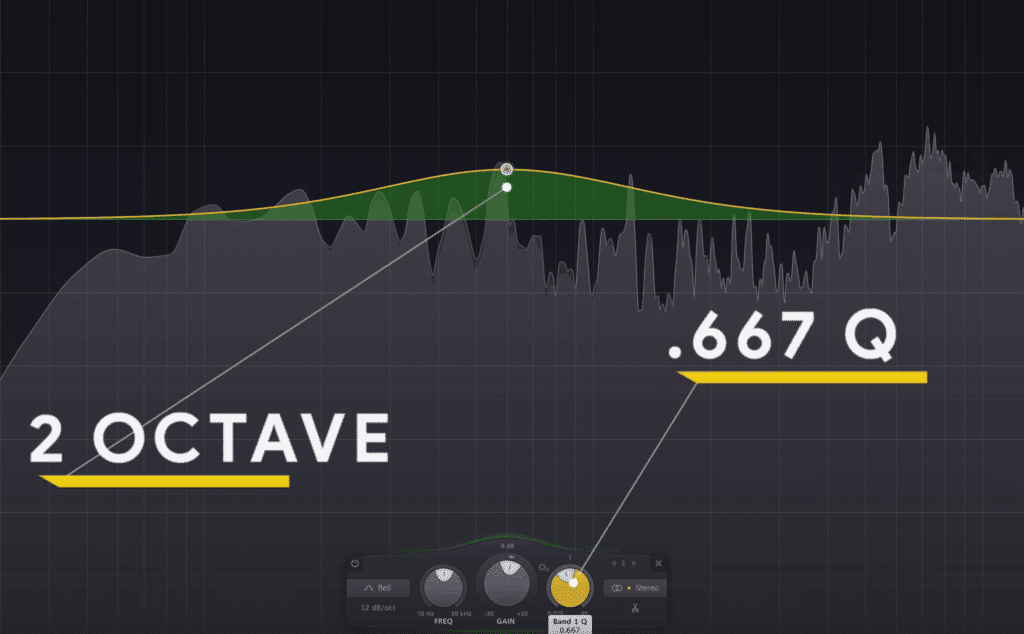
This results in a natural sound - the amplitude will most likely be lower than shown above.
1 Octave Bandwidth: 1.414 Q
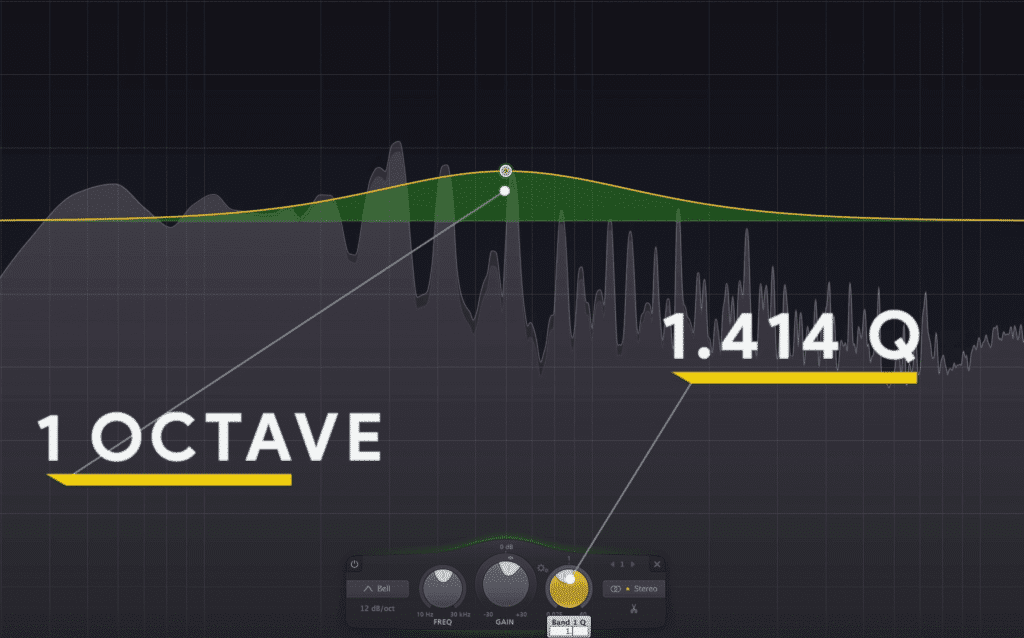
Octave-based bandwidths sound more musical, as they adhere to the musical scale.
1/2 Octave Bandwidth: 2.871 Q
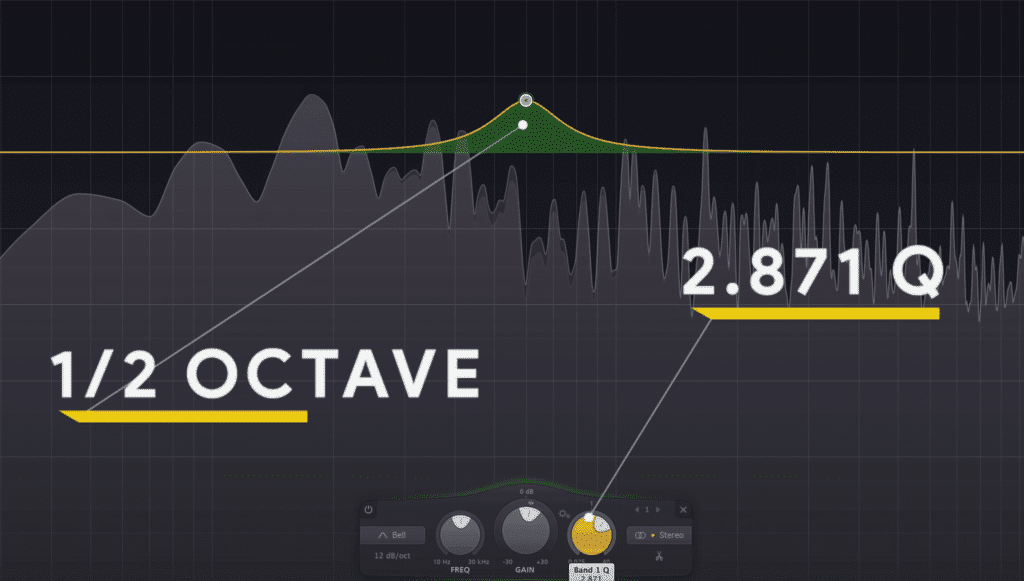
1/2 Octave bandwidths are great for fine-tuning a folk master.
The most natural-sounding of these Qs is the largest, 2-octave setting - but this may be too broad to equalize in the way you want.
However, if the changes are small, maybe 0.5dB to 1dB , then even these large settings will work well for a folk master.
In addition to using these settings, it may be best to use mid-side processing to have greater control over the signal.

Mid-side processing will give you more control over your signal.
For example, if you’d like to make the vocal more prevalent, you could slightly amplify 2kHz on the mid image and slightly attenuate 2kHz on the side image. This will make the frequencies that were masking the vocal become less prevalent.
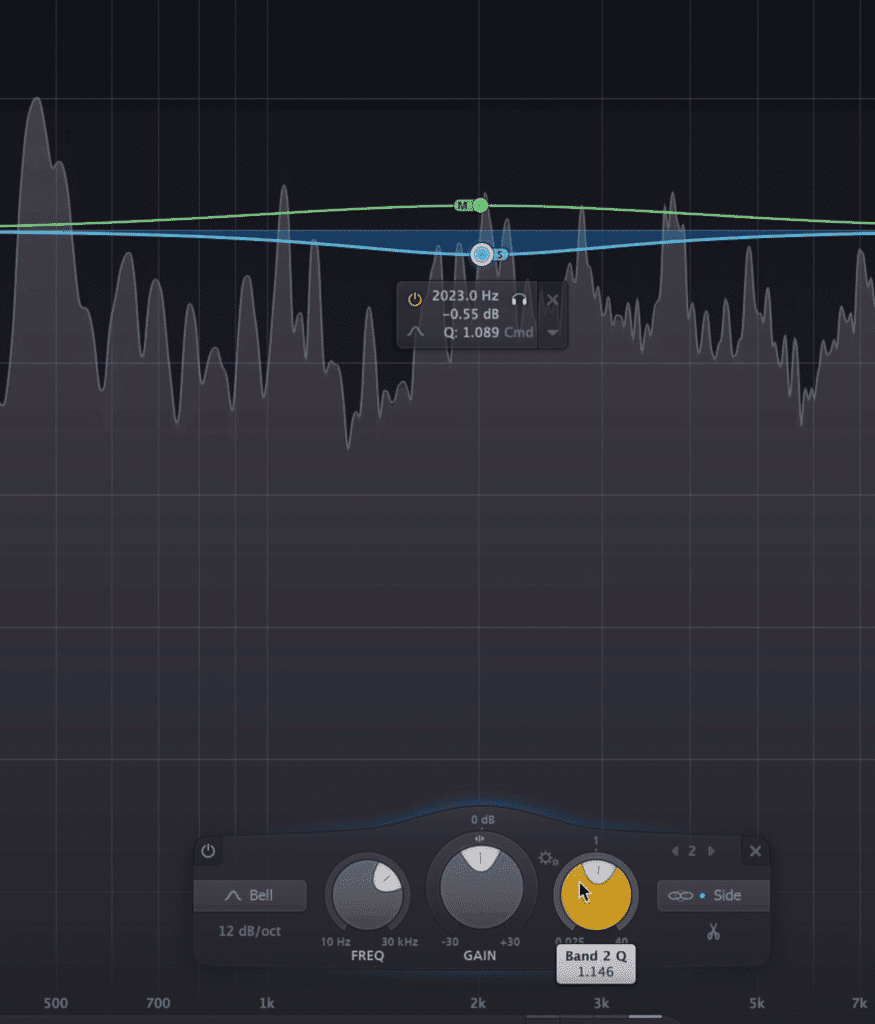
Amplifying 2kHz of the mid image and attenuating 2kHz on the side image will make the main vocal more present.
These choices depend heavily on the mix you received or are working on, so keep this in mind whenever making changes to your frequency response.
If you’d like to learn more about these Q settings, check out our blog post on the topic:
It covers some additional Q settings as well as explains an easy method for remembering these settings.
How Much Distortion Should I Use on My Folk Master?
1 to 2 percent of Total Harmonic Distortion can be really beneficial to the overall sound and presence of a folk master. Although distortion can be introduced via analog emulation plugins, using analog equipment will create the most authentic folk experience, and harken back to folk’s origins.

Using genuine analog equipment will create a more authentic folk master.
Harmonic generation, be it from tube, transistor, or tape saturation, has an incredibly beneficial effect on folk masters if introduced to the right degree.
Harmonic generation causes a signal to become more complex and full, as the gaps in the frequency response are filled, and the overall loudness and presence of the track increases.
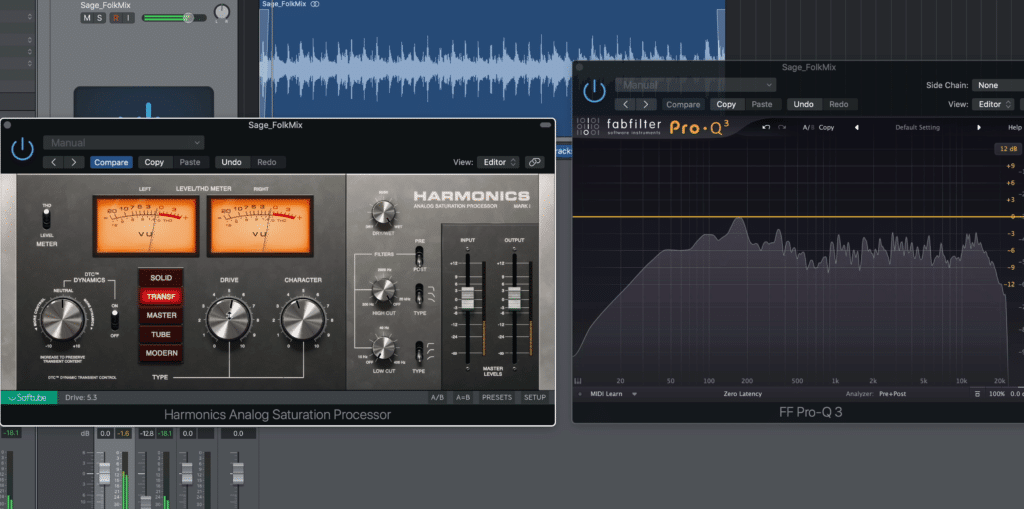
Saturation will make the overall loudness of your master increase.
If you’d like to introduce harmonics into your master, you can use an analog emulation plugin and increase the drive function. As stated previously , although these harmonic can be introduced via these plugins, actual analog equipment does yield better results.

Although plugins can create harmonics, for the most detailed harmonic generation, it's best to use analog equipment.
The reason being, analog equipment creates subtle and complex distortions and alterations to the signal that are too nuanced to be adequately represented in a digital domain.
That said, if you’re looking to create a folk master that sounds like the folk masters of Folk’s heyday, then it’s best to utilize the equipment that was around at that period in time.
Granted, you can still achieve a great folk master using entirely digital processing - it truly depends on how you use the tools available.

Some plugins include THD meters, which may be helpful to monitor.
The best way to determine how much you should distort your master is by listening critically to the changes the distortion makes on your signal - but you can also you THD meters on saturation plugins to get a visual representation.

Saturation plugins will compress your signal, so keep this in mind and don't add more compression than what's needed.
One more thing to note - if you’re using saturation plugins for your harmonic distortion, these saturation plugins will also compress your signal. That said, it may be best to avoid additional compression if you intend to use a saturation plugin on your folk master.
If you’d like to hear your folk track mastered with solely analog equipment, send us your mix here:
We’ll master it for you and send you a free sample for you to listen to.
How Wide Should My Folk Master Be?
The stereo imaging of a Folk master can be widened using mid-side equalization - this will accentuate the imaging established during the tracking and mixing sessions. Although stereo widening can make a folk master sound better, excessive widening will quickly worsen your master’s impact and presence.
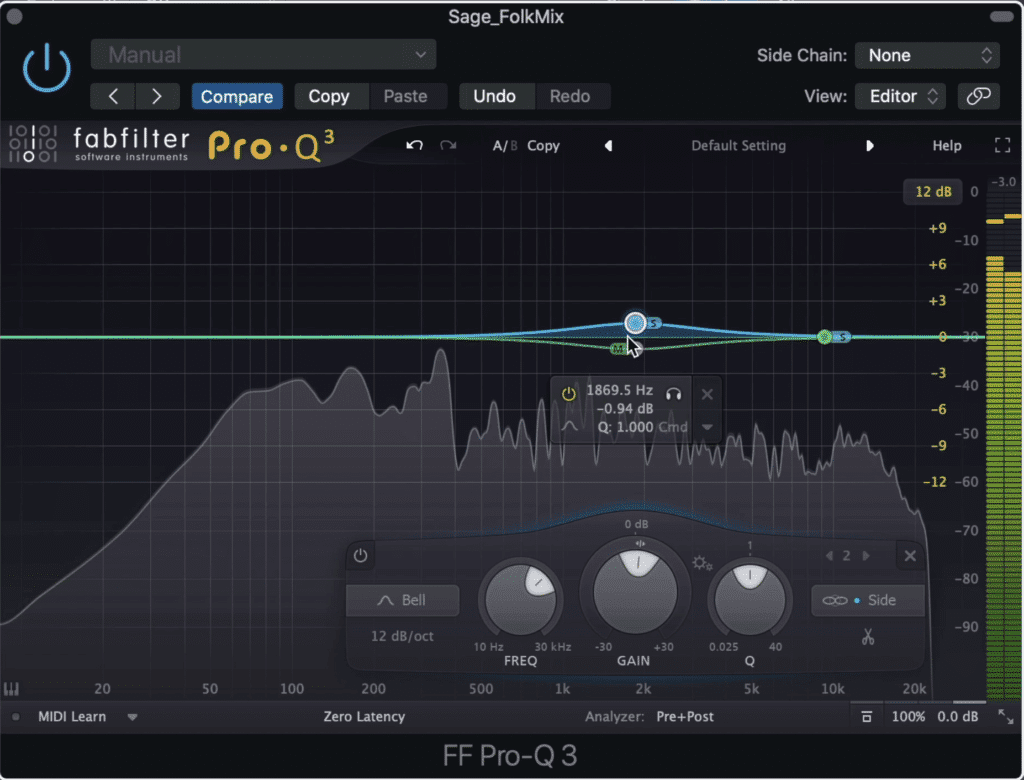
Stereo widening can be accomplished with mid-side equalization.
Mid-side equalization, as opposed to delay and phase-based stereo imaging, is a safe choice for widening your folk master’s stereo image, without introducing unwanted phase cancellation.

Delay-based imaging should typically be avoided to avoid unwanted phase cancellation.
When performing mid-side equalization, you have two options for widening the stereo image:
Increase the amplitude of side image frequencies, decrease the amplitude of your mid image frequencies, or both, by using various filters.
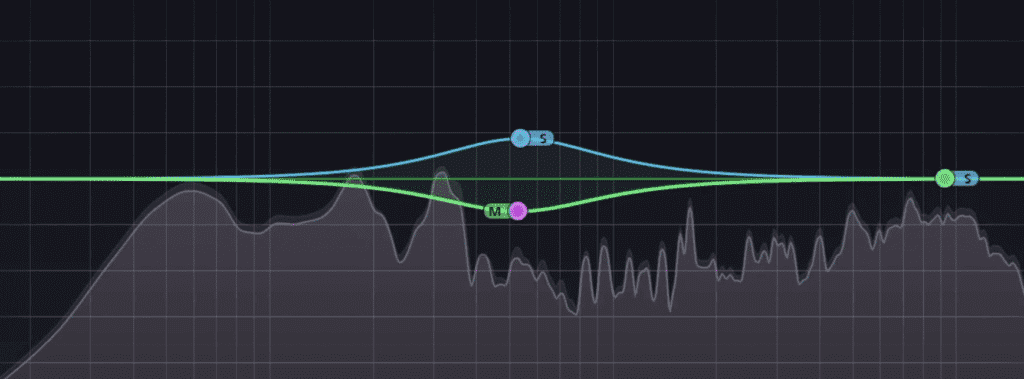
Affecting the bands will alter the stereo imaging.
Alter the output of your equalizer or adjust your output’s pan from Mid to Side.
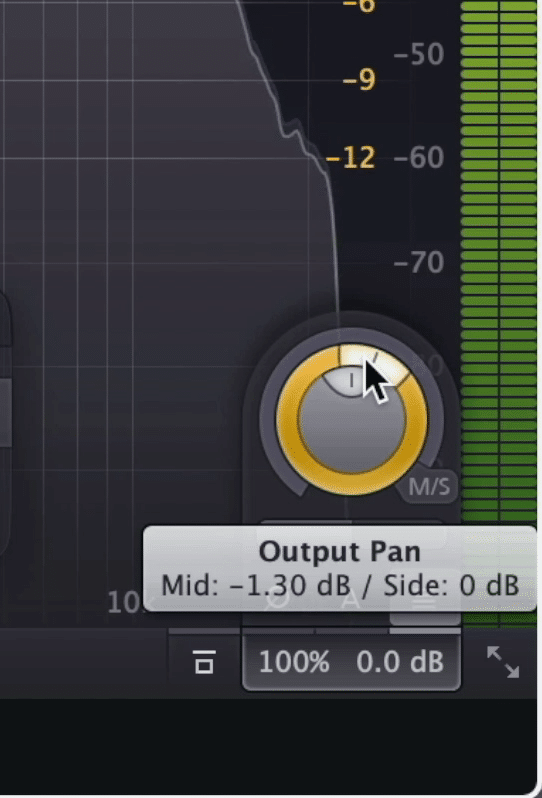
Altering the output's pan will alter the stereo imaging.
A quick way to make a folk master both brighter and wider is to amplify the side image with a shelf filter above 7kHz. This will amplify the higher harmonics of guitars and accentuate any airiness in the master.
If you’d like to learn more about stereo imaging, here’s a blog post and video we created on the very topic:
It offers a comprehensive description of stereo imaging during tracking, mixing, and mastering.
How Loud Should My Folk Master Be?
The loudness of a folk master can vary based on the intended medium of release - but if you intend to release your folk master on a streaming service, an integrated -14 LUFS is a good start. If you’d like to create a more commercial master -10 LUFS is acceptable.

How loud a folk master should be depends on the medium it'll be released on, and the artist's intentions.
Like most of the information provided here - everything needs to be taken with a grain of salt. How loud you make your folk master truly depends on the mix, the artist’s intentions, and the composition.
For example, if the folk master you’re creating is only comprised of an acoustic guitar and vocals, then making that master -10 LUFS will most likely be far too loud.
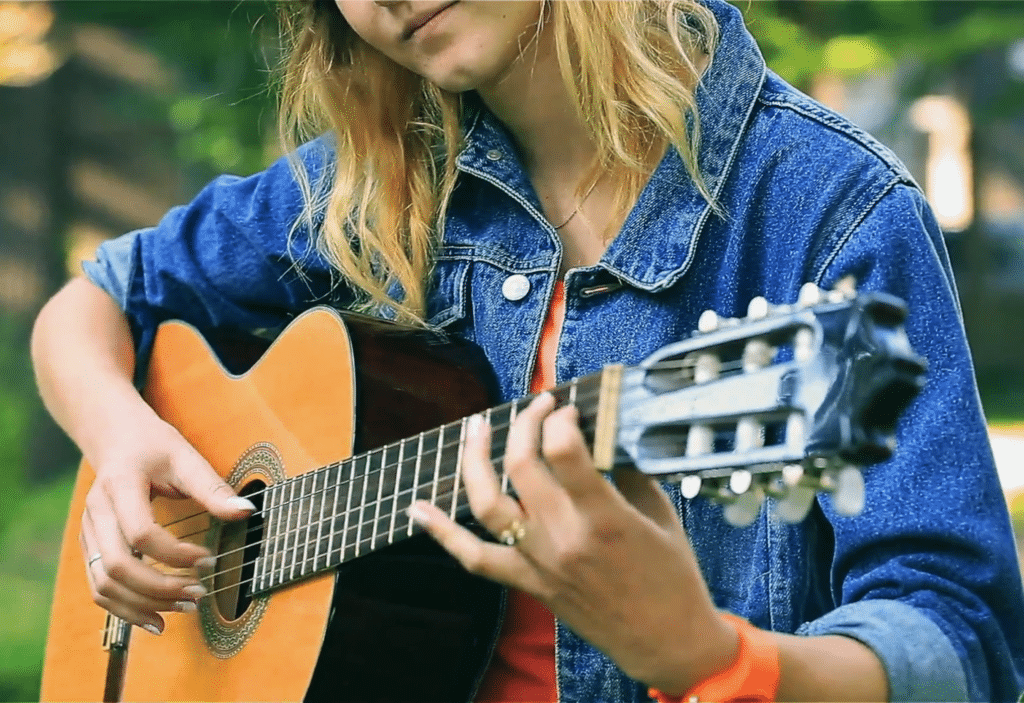
An acoustic folk master shouldn't be as loud as a full band folk master.
The reason being, that most other masters reach that level of loudness by having more instrumentation - including but not limited to drums and bass.
These high-energy instruments are responsible for a great deal of perceived loudness. That being said, making a vocal and guitar master as loud as a fully fleshed out arrangement is probably not the best decision.

A full band folk master will have a greater LUFS due to its high-energy instrumentation.
If you’re looking for a way to set a loudness for your folk EP or album, then the best way to do so is by mastering your loudest, most complex track first. The track you choose should have the most instrumentation and have the greatest amount of high-energy instruments.
Once you’ve mastered this track to say, -10 LUFS , then master the other, softer tracks with this track as the reference.
A good way to get these tracks to match the reference is by matching the perceived loudness of the vocal, not the entire track. This way you’ll end up with a mastered album that sounds balanced , without any jarring or out of place transitions from one master to the next.
If you’d like to learn more about mastering and loudness, check out our blog post on the topic:
It showcases how loudness is affected when distributing a master to a streaming service.
If you intend to have your folk master distributed on a different medium like vinyl, check out our blog post detailing how to master for vinyl:
It offers a step-by-step process for creating a great master for vinyl, as well as technical explanations along the way.
Conclusion
Mastering for folk music is hard to pin down - there are many instances in which a master can be performed in a multitude of ways, all depending on the mix that is being mastered.
But there are some takeaways that are almost universal for mastering all folk music.
A folk master should maintain its dynamic range and shouldn’t be subject to heavy compression and limiting. Although your folk music master shouldn’t be as dynamic as a classical recording, it shouldn’t be as compressed as a pop or hip-hop master.
Your folk master should retain the frequency response of the mix , but with some minor adjustments as needed. When performing these adjustments be sure not to use aggressive boosts or cuts, and to use more natural-sounding larger bandwidths.
Your mastershould include mild to moderate harmonic distortion which can be accomplished with analog equipment or via analog emulation plugins. If you want to create a folk master indicative of folk masters during the genre’s heyday, then an analog mastering setup or service is the best option.
Your master shouldn’t have an excessively wide stereo image - instead, you can use a mid-side equalizer to gently increase the width or amplitude of the side image.
And lastly, your folk master should range in loudness from an integrated -14 LUFS to -10 LUFS. Keep in mind that mixes with simpler compositions will not need to be as loud as full compositions; mastering these simple mixes as loud as complex mixes won’t result in a balanced sound.
If you have a folk track that you’d like to hear mastered, send it to us here:
We’ll master it for you and send you a free sample for you to review.
Have you ever mastered a folk album before?




